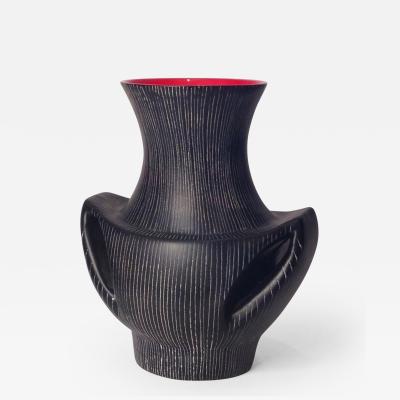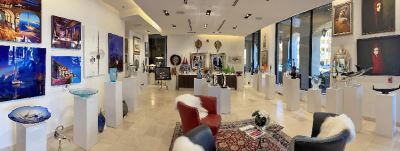Winter Antiques Show Loan Exhibition — Storied Clay: African-American Ceramics at the Virginia Museum of Fine Arts
Two Recent Acquisitions
 |
 |
 | |
| Fig. 1: Double-handled jug, 1840, David Drake (ca.1800–after 1870), Lewis J. Miles Factory, Horse Creek Valley, Edgefield District, S.C. (active ca. 1830–1879). Stoneware with alkaline glaze. Signed, dated, and inscribed by the artist: “L. Miles Dave”/“January 29 1840”/“Ladys & gentlemens Shoes =/ Sell all you can & nothing you’ll loose!” VMFA; Floyd D. and Anne C. Gottwald Fund and Gift of Dr. and Mrs. John E. Hoar (2017.150). |
Despite stark impediments, enslaved African Americans in the antebellum South found means of claiming cultural liberation. Folktales, musical instruments, song and dance crossed the Atlantic to merge with country-born mores in the expression of individual and group identities. Enslaved people also drew on their talents with material goods to demonstrate individuality and self-worth. While opportunities for self-expression by blacksmiths, carpenters, cabinetmakers, and other artisans was often limited by the physical nature of their respective media, quilt and ceramics makers had a freer hand, making them a particularly provocative resource for understanding the past.
In the fall of 2017, the Virginia Museum of Fine Arts acquired what is believed to be the earliest signed and dated poem piece produced by the enslaved artisan, David Drake (ca. 1800–ca. 1870s). Popularly known as “Dave the Potter” (Fig. 1), Drake was acquired by Harvey Drake (ca. 1796–1832) when he was approximately 15 years old, about the time Harvey Drake partnered with his uncle Dr. Abner Landrum in the Pottersville Stoneware Manufactory. By 1840, when David Drake turned this jug, Harvey Drake had died, and Dave was working for Landrum’s son-in-law, Lewis Miles, at his pottery on Big Horse Creek in the Edgefield District of South Carolina. The training of enslaved African Americans as potters was a distinctly southern development conditioned by plantation demographics and the need for large-scale utilitarian wares suited to food and liquid storage. But Drake’s pots signal another advantage of pottery work: a surface receptive to inscription. While VMFA’s jug is detailed with a verse that passively alludes to the plantation’s tannery industry—“Ladys & gentlemens Shoes/Sell all you can & nothing you’ll loose!” the physical incising of Dave’s name on the clay surface, in partnership with that of his owner, points to very different intentions, including a blatant disregard of South Carolina’s strict slave anti-literacy laws, an action that raises questions not only about Dave’s place and degree of autonomy within the Edgefield community, but his relationship with his owner, Lewis Miles, who might have been punished for permitting such a display. Moreover, the authored couplets bring to mind the kind of everyday wisdoms found in popular works like Benjamin Franklin’s Poor Richard’s Almanack (1739), a style of couplet that may have been inspired by the poetry Dave knew from his exposure to The Hive, a newspaper published by Dave’s one-time owner, Dr. Abner Landrum. Drake appears to have been armored with an extralegal Teflon shield likely merited by his extraordinary talents. His fame among his contemporaries, black and white, enslaved and free, suggests his probable acquaintance with another potter of scholarly interest: the maker of VMFA’s recently acquired face cup (Fig. 2).
 | |
| Fig. 2: Face cup, Unidentified artist, possibly Tahro (Romeo Thomas), ca. 1862. Palmetto Fire Brick Works, Edgefield District, S.C. Stoneware, alkaline glaze. VMFA; Arthur and Margaret Glasgow Endowment (2016.5). |
Though the origin and meaning of face wares is still speculative, African American variations have been interpreted as a fusion of European and African wares, notably the anthropomorphic wooden power figures called nkisi used by Kongo people as mediums for receiving or activating the help of otherworldly spirits. Those dating before Emancipation are thought to have been produced at three Edgefield potteries, owned, respectively, by Thomas Davies, Lewis Miles, and Miles’ brother-in-law Benjamin Franklin “B. F.” Landrum.
It has also been proposed that the maker of the face cup illustrated, and the inspiration for the larger body of wares produced at the three sites, came from the illegal slave ship Wanderer. The story of the Wanderer excited considerable attention in its own day and continues to be a focus of extensive research. The swift-sailing vessel with ties to the New York Yacht Club was commissioned by the New Orleans sugar magnate Colonel John D. Johnson in 1857, and promptly resold to William C. Corrie of Charleston. Corrie subsequently partnered with Charles A. L. Lamar of Savannah in a scheme to refashion the yacht as an illegal slave ship. Fifty years after the 1807 Act Prohibiting Importation of Slaves, the Wanderer arrived in West Africa, where it was met and outfitted for a contracted five hundred slaves by the agent of a New York illegal slave-trading firm. Returning to Jekyll Island, Georgia, in November 1858, it regrouped the surviving 409 of 487 men, women, and children for further transfer and sale. An estimated 170 of the captives were brought up the Savannah River to the mouth of Horse Creek on the steamboat Augusta. Twenty-three were purchased by Thomas Davies. Among them was a Kakongo-speaking captive named Tahro—subsequently named Romeo Thomas—who was born in the village of Kuluwäka in the Kingdom of Kongo. To date, Tahro is credited with being a master turner at Davies’ pottery and the possible maker of, or inspiration for, VMFA’s face cup.
These modest forms provide a lens on the life and personality of two enslaved potters. Equally compelling is their shared experience as master potters in a single community. Recent scholarship points to the possibility of their reciprocal influence in the form of a monumental face jar attributed to David Drake and an Edgefield pot by an unidentified maker that is inscribed in what appears to be Kongo script. Storied clay indeed.1
Susan J. Rawles is associate curator of American painting and decorative art, Virginia Museum of Fine Arts.
This article was written for the VMFA's loan show exhibition at the 2018 Winter Antiques Show (January 19-28) at the Park Avenue Armory, NYC.
This article was originally published in the 18th Anniversary/Spring issue of Antiques & Fine Art magazine, a fully digitized version of which is available at www.afamag.com. AFA is affiliated with Incollect.































